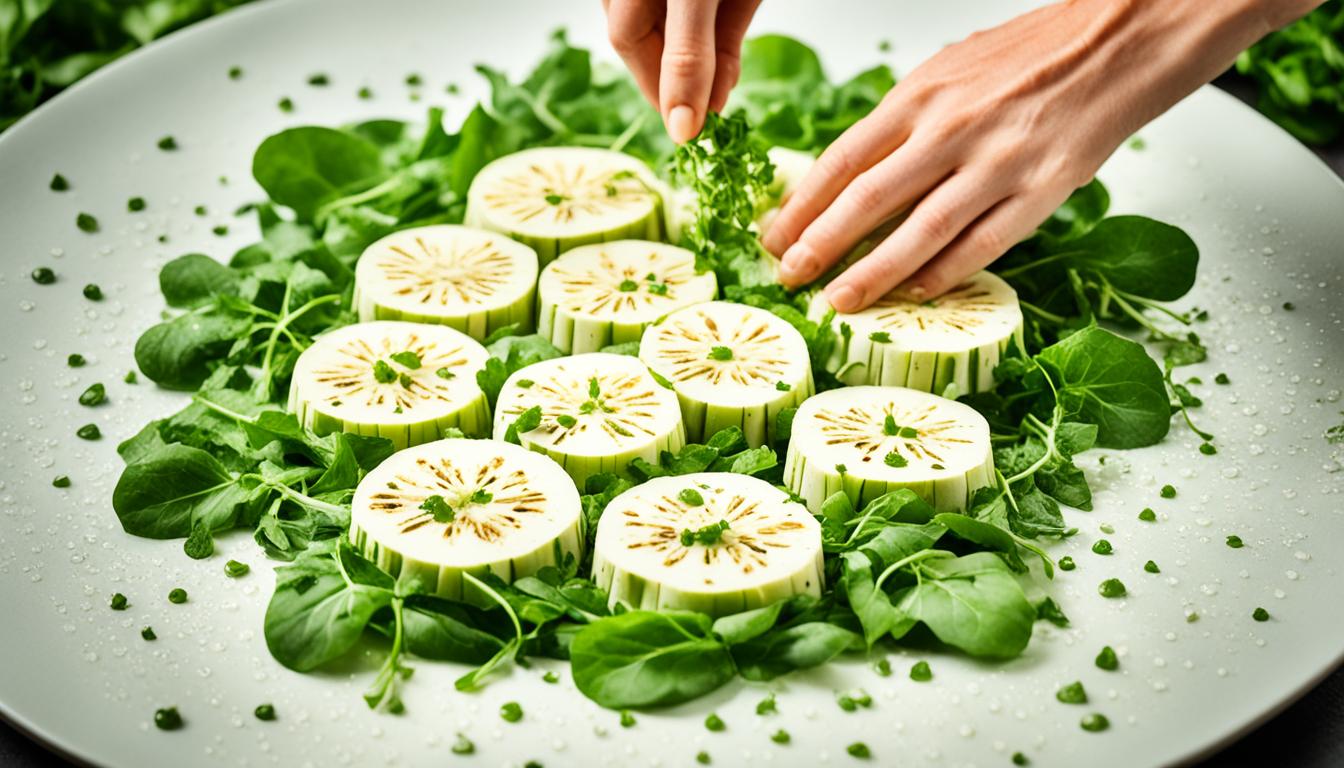Celeriac is a standout root vegetable filled with health benefits. It adds a special taste and texture to meals, not to mention its nutritional value. Adding it to your meals can boost your health in many ways.
Known as celery root, celeriac is a relative of the celery we eat. It looks rough outside but has a potato-like inside. It comes from the Mediterranean but is now loved in kitchens around the world.
Key Takeaways:
- Celeriac is a versatile root vegetable that is rich in essential vitamins, minerals, and antioxidants.
- Including celeriac in your diet can improve digestion, promote heart health, and support bone strength.
- Its impressive nutrient profile includes vitamins B6, C, and K, as well as minerals like phosphorus, potassium, and manganese.
- Celeriac offers potential health benefits such as protection against diseases, improved heart health, and enhanced bone density.
- Enjoy celeriac raw in salads or try it cooked in various dishes like soups, mashes, or roasted meals for added flavor and nutrition.
What is Celeriac?
Celeriac is also called turnip-rooted celery or celery root. It’s a root veggie that’s like celery but from the Mediterranean. It belongs to the carrot family. Celeriac has a rough surface and white insides, like a potato. It’s used in salads and soups in Eastern and Northern Europe.
Ever seen a veggie with a tough outside and creamy inside? That’s celeriac. It looks like celery but is a different kind. It may not look pretty, but it’s tasty and full of nutrients once peeled.
Celeriac is a culinary treasure. Its flavor boosts many dishes. It’s also packed with good nutrients. If you want to try new flavors or eat healthier, try celeriac.
In Eastern and Northern Europe, celeriac is a key food. It’s great in soups, stews, salads, and sides. You can eat it raw or cooked, which shows off its flavors and textures.
If you’re in the mood for a crunchy salad, try celeriac. Julienned or sliced thin, mix it with your favorite dressing. It’s a fresh take on salads.
Celeriac holds up well in soups and purees too. When cooked, it has a nutty flavor. It makes soups smooth and side dishes creamy. Celeriac will win you over.
Don’t be put off by celeriac’s looks. Peeling it is simple. Underneath is smooth, creamy flesh. You can chop it up however you like for cooking.
Let’s dive into celeriac’s nutrients now. We’re going to see how it’s healthy and how it helps us. Stay tuned for more on celeriac’s health benefits.
Impressive Nutrient Profile
Celeriac is more than a tasty addition to your table. It’s a nutrition giant. Packed with key vitamins, minerals, and fiber, it boosts your diet.
It shines with vitamins B6, C, and K. These vitamins are crucial for your body. Vitamin B6 supports metabolism and brain development. Vitamin C boosts the immune system. Vitamin K is good for blood clotting and bones.
Celeriac is rich in minerals like phosphorus, potassium, and manganese too. Phosphorus strengthens teeth and bones. Potassium helps your heart and blood pressure. Manganese aids in metabolism and fights free radicals.
This root is low in fat and calories, ideal for a light diet. Its fiber keeps your digestive system happy and you full longer.
Here’s what a 100-gram serving of celeriac offers:
| Nutrient | Amount |
|---|---|
| Fiber | 1.8 grams |
| Vitamin B6 | 0.1 milligrams |
| Vitamin C | 8.0 milligrams |
| Vitamin K | 41.0 micrograms |
| Phosphorus | 76.0 milligrams |
| Potassium | 300.0 milligrams |
| Manganese | 0.2 milligrams |
Clearly, celeriac has lots of vital nutrients for our health. Adding celeriac to your meals is an easy way to get those benefits. And it’s tasty too.
Potential Health Benefits
Celeriac is packed with good things for your health. It’s full of antioxidants that help protect you from heart disease, cancer, and Alzheimer’s. This veggie is also high in potassium and vitamin K, which may make your heart stronger and lower your stroke risk.
Its fiber content is great for digestion and might even prevent colon cancer. Plus, the vitamin K and phosphorus in celeriac help make your bones stronger. This could mean fewer fractures.
| Benefits of Celeriac | Health Benefits of Celeriac |
|---|---|
| Rich in antioxidants | Protects against heart disease, cancer, and Alzheimer’s |
| High potassium content | Improves heart health, reduces the risk of stroke |
| Aids in digestion | Supports colon health, may prevent colon cancer |
| Vitamin K and phosphorus | Strengthens bones, reduces the risk of fractures |
Easy to Add to Your Diet
Celeriac is incredibly versatile and can fit into many dishes. You can eat it raw or cook it in different ways. It’s great in salads, coleslaws, and soups. You can also enjoy it mashed, baked, roasted, or boiled.
When picking celeriac, go for a medium-sized, firm bulb. Make sure it looks smooth. To use it, just wash, peel, and chop. Then, add it to your favorite meals.
| Cooking Method | Description |
|---|---|
| Mashed | Boil the celeriac until tender, then mash it with butter, salt, and pepper for a creamy side dish. |
| Baked | Slice the celeriac into thin rounds, toss with olive oil, salt, and herbs, then bake in the oven until golden and crispy. |
| Roasted | Cut the celeriac into cubes, toss with oil and seasonings, then roast until caramelized and tender. |
| Boiled | Cook the celeriac in boiling water until fork-tender, then use it as a replacement for potatoes in various dishes. |
Looking for celeriac recipes? Here are a few ideas:
- Celeriac Salad: Mix grated celeriac, shredded carrots, toasted walnuts, and a tangy dressing for a crisp salad.
- Celeriac Soup: Cook celeriac with onions, garlic, and vegetable broth. Blend until smooth for a creamy soup.
- Roasted Celeriac: Combine cubed celeriac with olive oil, rosemary, and garlic. Roast until it’s golden.
- Celeriac Mash: Boil celeriac until soft. Mash with butter, cream, and seasonings for a tasty side dish.
Try various cooking methods and recipes to find your favorite way to enjoy celeriac. It’s a great choice for anyone looking to add a nutritious side dish to their meals or explore new flavors. Celeriac will make your dishes stand out.
Safety Concerns
Celeriac is usually safe for many people. However, some should be careful or not eat it at all. If you have health issues, talking to a healthcare provider is wise before adding celeriac to your meals.
Who Should Avoid Celeriac?
Some folks need to be extra cautious with celeriac:
- People with blood-clotting issues should watch out. Celeriac has vitamin K, which might conflict with blood thinners. If you’re dealing with clotting problems or on such medications, consider cutting back on celeriac.
- If your kidneys aren’t working well, stay alert. Since celeriac is rich in potassium, those with kidney troubles should keep an eye on their potassium levels. Check with your doctor before bringing celeriac into your diet.
- Those on certain drugs need to be careful, too. Medications like potassium-sparing diuretics can raise potassium in the body. Speak to your healthcare provider before you start eating celeriac if these medications are part of your regimen.
- Pregnant ladies should limit celeriac. It has compounds that might kickstart uterine contractions. While eating it in small amounts is okay, it’s safer to avoid large servings to prevent any effects on contractions.
Don’t forget, this guide isn’t a substitute for medical advice. For any worries or questions on celeriac safety, best to get advice from a healthcare pro.
The Bottom Line
Celeriac is a nutritious and flexible root vegetable with many health benefits. It’s packed with nutrients and can help with digestion, heart health, and bone strength. You’ll get a lot out of it whether you eat it raw or cooked.
This veggie is loaded with vitamins B6, C, and K, plus potassium and manganese. It’s high in fiber but low in fat and calories, a better choice than potatoes. Including celeriac in your diet can fight off heart disease, cancer, and Alzheimer’s, thanks to its antioxidants.
“Celeriac’s high potassium and vitamin K content may improve heart health and reduce the risk of stroke. Its fiber content supports digestion and may prevent colon cancer. Additionally, celeriac’s vitamin K and phosphorus contribute to strong bones, reducing the risk of fractures.”
Celeriac’s real charm comes from how versatile it is in cooking. Enjoy it raw in salads or slaws for a bit of crunch. Or, try it boiled and mashed, roasted, or baked. You can even blend it into soups and sauces.
To choose the best celeriac, look for a medium, firm bulb with a smooth surface. Stay away from bigger, discolored ones. Clean, peel, and chop it for your recipes. To keep it from turning brown, soak the chopped pieces in cold water with lemon or vinegar.
In summary, celeriac is a great yet underrated veggie for your kitchen. It’s not only tasty but also offers massive health perks. It can improve your digestion, heart health, and bone strength. Celeriac could be just what you need to reach your health goals.
Selection, Preparation, and Storage
Look for a medium-sized bulb of celeriac that feels smooth. Bigger bulbs might not taste as good. Avoid any that are discolored or have cracks, as these could be bad.
Cleaning celeriac is easy. Just wash it well to get rid of dirt. Then peel off the thick skin with a peeler, showing its white inside. Cut away any rough spots or roots.
To keep it from turning brown, soak the cut celeriac in cold water. Add some lemon slices or vinegar to the water.
“Soaking celeriac in a mixture of cold water and lemon slices or vinegar helps maintain its vibrant color and prevents it from turning brown.”
Store celeriac like you would other root veggies. Whether peeled or not, put it in a plastic bag in the fridge’s veggie drawer. This keeps it fresh. Try to use it within a week for the best taste.
Cooking Methods for Celeriac
Celeriac is a tasty and versatile veggie that you can enjoy many ways. You can eat it raw or cooked, offering several yummy choices. Let’s dive into some cooking techniques to bring out the best in celeriac.
Sliced or Grated in Salads or Coleslaws
For a crunch and mild celery taste in salads or coleslaws, slice or grate celeriac. Its fresh flavor will spice up your meals. Just peel it and slice thinly or grate it.
Boiled and Mashed
Want a new twist on mashed potatoes? Try boiling and mashing celeriac. Peel and cube it first, then boil until it’s soft. Mash it up with some butter or olive oil, salt, and pepper for flavor.
Roasted or Baked like Potatoes
Roasting or baking celeriac brings out its sweetness. Peel and cut it into chunks or wedges. Mix with olive oil, salt, and your chosen herbs, then bake until it’s wonderfully golden.
Cooked and Blended for Soups, Sauces, and Casseroles
Celeriac works great in soups, sauces, and casseroles because of its creamy texture. Peel, chop, cook it until soft, then blend it. It makes your favorite dishes richer and more flavorful.
Remember, cooking times can change depending on how big or thick your celeriac pieces are. Check if it’s soft enough by poking it with a fork or knife.
Cooking Methods for Celeriac
| Method | Cooking Steps | Cooking Time |
|---|---|---|
| Sliced or Grated in Salads or Coleslaws | Peel and slice or grate celeriac. Add it to salads or coleslaws. | N/A |
| Boiled and Mashed | Peel and cube celeriac. Boil until tender. Drain and mash with butter or oil, salt, and pepper. | Approx. 20 minutes |
| Roasted or Baked | Peel and cut celeriac into chunks or wedges. Toss in olive oil, salt, and desired seasonings. Roast or bake until golden. | Approx. 40 minutes |
| Cooked and Blended for Soups, Sauces, and Casseroles | Peel and chop celeriac. Cook until tender. Blend with other ingredients to create soups, sauces, or casseroles. | N/A |
What’s your favorite way to cook celeriac? Share with us in the comments below!
Celeriac Recipe Ideas
If you’re looking for delicious ways to incorporate celeriac into your meals, we’ve got you covered! Check out these mouthwatering recipes that highlight the versatility and flavor of this incredible root vegetable.
Celeriac Soup Recipe
Warm up with a comforting bowl of celeriac soup. This creamy and aromatic soup is perfect for chilly days. It makes a satisfying meal on its own. Here’s a simple recipe to get you started:
Ingredients:
- 1 celeriac, peeled and diced
- 1 onion, chopped
- 2 cloves of garlic, minced
- 4 cups vegetable broth
- 1 cup heavy cream
- Salt and pepper to taste
Instructions:
- In a large pot, sauté the onion and garlic until softened.
- Add the celeriac and vegetable broth. Bring to a boil, then reduce heat and simmer until the celeriac is tender.
- Using an immersion blender or a regular blender, purée the soup until smooth.
- Return the soup to the pot, stir in the heavy cream, and season with salt and pepper.
- Simmer for a few more minutes to heat through.
- Serve hot and garnish with your favorite herbs or croutons.
Celeriac Salad
For a refreshing and crunchy salad, try this celeriac salad recipe. It combines crisp celeriac, tangy dressing, and fresh herbs. This makes for a delightful side dish or light lunch.
Ingredients:
- 1 celeriac, peeled and julienned
- 2 carrots, julienned
- 1 apple, sliced
- ¼ cup chopped fresh parsley
- ¼ cup chopped fresh dill
- ¼ cup lemon juice
- 2 tablespoons olive oil
- Salt and pepper to taste
Instructions:
- In a large bowl, combine the celeriac, carrots, apple, parsley, and dill.
- In a small bowl, whisk together the lemon juice, olive oil, salt, and pepper.
- Pour the dressing over the salad and toss to coat.
- Let the salad marinate in the fridge for at least 30 minutes before serving.
- Enjoy the refreshing flavors of the celeriac salad!
Roasted Celeriac
Roasting celeriac brings out its natural sweetness and creates a deliciously caramelized exterior. Serve it as a flavorful side dish or use it as a base for roasted vegetable bowls.
Ingredients:
- 1 celeriac, peeled and cut into wedges
- 2 tablespoons olive oil
- 1 teaspoon paprika
- 1 teaspoon garlic powder
- Salt and pepper to taste
Instructions:
- Preheat the oven to 400°F (200°C).
- In a mixing bowl, toss the celeriac wedges with olive oil, paprika, garlic powder, salt, and pepper.
- Spread the seasoned celeriac evenly on a baking sheet.
- Roast for 30-40 minutes, or until the edges are golden brown and crispy.
- Remove from the oven and let cool slightly before serving.
- Savor the irresistible flavors of roasted celeriac!
Celeriac Mash
Swap out traditional mashed potatoes for creamy celeriac mash. This flavorful alternative is lower in carbs. It adds a unique twist to your favorite dishes.
Ingredients:
- 1 celeriac, peeled and cubed
- 2 cloves of garlic, minced
- ¼ cup butter
- ¼ cup heavy cream
- Salt and pepper to taste
Instructions:
- In a large pot, bring salted water to a boil.
- Add the celeriac cubes and minced garlic. Boil until the celeriac is tender.
- Drain the celeriac and garlic, then return them to the pot.
- Mash the celeriac and garlic with a potato masher or fork until smooth and creamy.
- Stir in the butter, heavy cream, salt, and pepper.
- Heat the mash over low heat, stirring until heated through.
- Serve the celeriac mash as a delicious side dish to complement your main course.
With these recipe ideas, you’ll be able to enjoy the rich flavors and nutritional benefits of celeriac in various dishes. Experiment with different cooking methods and let your culinary creativity shine!
Other Names for Celeriac
Celeriac is also known as knob celery or turnip-rooted celery. It’s a unique root vegetable with a tasty flavor. It’s used in many delicious ways.
These names mean the same thing but highlight different features. They all describe a nutritious, tasty vegetable for your meals.
Knob celery points out the vegetable’s knobby look. Unlike regular celery stalks, its rough surface brings texture to dishes.
Its taste reminds you of celery but with parsley notes. People often call it earthy and nutty.
Turnip-rooted celery looks like a turnip. Its white inside and gentle taste make it a great potato replacement.
Call it celeriac, knob celery, or turnip-rooted celery, this veggie shines in stews, soups, salads, and more.
Conclusion
Celeriac is an underrated veggie with many great points. It’s flexible and can be eaten raw or cooked. This adds an exciting twist to your food. It’s also full of vitamins and minerals, boosting your health.
Adding celeriac to your diet brings lots of health perks. It has antioxidants that fight disease. It’s good for your heart and bones too. This tough root veggie is a nutrition powerhouse.
Don’t overlook celeriac’s goodness. Start using this unique veggie in your cooking. It will enhance your dishes and give your body important nutrients. Try celeriac for its flavor and health benefits, making it a key part of your meals.





